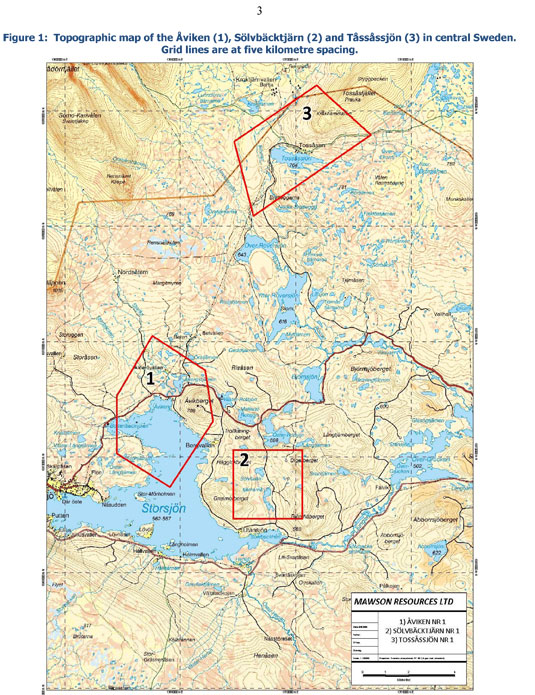Vancouver, Canada - Mawson Resources Limited ("Mawson") TSX -- MAW; Frankfurt - MRY Vancouver: Mr. Michael Hudson, President & CEO, announces staking of three high grade and near surface sandstone-hosted uranium prospects in Central Sweden. The prospects, together known as the Kapell project, are located within fifteen kilometres of each other in the Berg community of the Jämtland province and are held by three 100% owned permit applications which total 4,374 hectares.
The projects were discovered and explored by the Swedish Geological Survey (SGU) in the 1970's during the country's energy self sufficiency program and were more recently held by a third party company. Historic exploration highlights include:
Aviken 2.65 m (at) 1.54% eU(3)O(8) from 21.8 m (drill hole
AVI75402)
2.65 m (at) 1.05% eU(3)O(8) from 3.2 m (drill
hole AVI75401)
Solvbacktjarn 1.55 m (at) 2.38% eU(3)O(8) from 8.35m (drill hole
SOL75008)
Tossassjon 18 mineralized outcrops over 1.6 km strike length, 392
uranium mineralized boulders, never drilledMineralization at the three localities is developed within a sequence of conglomerates and heavy mineral bearing sandstone that form the lowermost stratigraphic units of the Caledonide age "Särve Nappe" suite. A regional scale diabase intrusion (the Ottfjäll diabase) overlies the mineralization. The Särve Nappe rests unconformably upon the allochthonous "Offerdal Nappe", which consists of strongly deformed sedimentary rocks. Uranium occurs in the form of pitchblende. eU3O8 values provided are equivalent uranium oxide values as determined by downhole radiometric logging equipment. Radiometric logging was carried out by the Swedish Geological Survey geophysical staff during 1975, using calibrated probes and protocols of the day. Core intervals will be assayed by Mawson to confirm historic eU3O8 results.
Åviken
The Åviken prospect was discovered in 1973 with the discovery of 401 mineralized boulders in three distinct boulder trains over a 1200 metre by 600 metre area. Mineralization is hosted by a porous sandstone bound by limestone and calcareous shale. Historic work includes detailed boulder tracing, resistivity and IP-surveys. The source of the boulder trains was targeted by 17 percussion holes and 36 diamond drill holes during 1975 and 1976. Eleven diamond drill holes intersected significant mineralization, with better results including 2.65 metres for 1.54% ppm eU3O8 from 21.8 m (drill hole AVI75401) and 2.65 metres for 1.05% ppm eU3O8 from 3.2 m (drill hole AVI75402).
Sölvbäcktjärn
The Sölvbäcktjärn prospect was discovered in 1973 where mineralization is again hosted by porous sandstone. The initial discovery consisted of high grade uranium and copper mineralized boulders. Work by the SGU outlined a boulder train of 57 boulders, which was followed up with radon, IP and resistivity surveys. The radon survey delineated several anomalies which were tested by 216 percussion drill holes (average 22 metres deep) and 15 diamond drill holes. Drilling confirmed widespread, but erratic uranium mineralization controlled by faulting and folding with a best result of 1.55 metres for 2.38% eU3O8 from 8.35m (drill hole SOL75008).
Tossåssjön
The Tossåssjön prospect was discovered by the SGU in 1975 during regional geochemical surveys. Mineralization is hosted by a heavy mineral bearing sandstone and a 0.5 to 2 metre thick conglomerate. Detailed boulder tracing and geological mapping conducted by the SGU discovered 18 mineralized outcrops and 392 mineralized boulders with strong radioactivity. The uranium mineralized outcrops lie over a strike length of 1.8 kilometres whilst mineralized boulders extend over a greater distance. Geochemical assays from five outcrops ranged from 0.13% to 1.39% U3O8 and averaged 0.48% U3O8. The mineralization in both outcrop and boulders is associated with significant Cu and Ag, with assays ranging from 9 ppm to >13,000 ppm Cu and from nil to >100g/t Ag. The Tossåssjön project is yet to be drill tested.
Mr Hudson states, "The Kapell project offers a new and attractive style of uranium mineralization for Mawson in Sweden and complements the Company's extensive uranium portfolio in Scandinavia. Sandstone hosted systems can form large, good grade and metallurgically amenable orebodies. At Kapell high grade mineralization over 1% U3O8 has been discovered near surface at all three project areas, which lie within 15 kilometres of each other. Further geological mapping, scintillometer surveying and ground magnetics will be undertaken during this summer before drill testing. The prospects remain open in all directions and form high merit exploration targets."
The qualified person for the Kapell project, Mark Saxon, director and vice-president of exploration for Mawson, and a member of the Australasian Institute of Mining and Metallurgy, has reviewed and verified the contents of this release.
On behalf of the Board,
"Michael Hudson"
Michael Hudson, President & CEO
Investor Information
www.mawsonresources.com
1305 -- 1090 West Georgia St., Vancouver, BC, V6E 3V7
Company Contact: Mariana Bermudez +1 (604) 685 9316
Investor Relation Consultants - Mining Interactive
Nick Nicolaas +1 (604) 657 4058
Email: info@mawsonresources.com
Forward Looking Statement. The statements herein that are not historical facts are forward-looking statements. These statements address future events and conditions and so involve inherent risks and uncertainties, as disclosed under the heading "Risk Factors" in the company's periodic filings with Canadian securities regulators. Actual results could differ from those currently projected. The Company does not assume the obligation to update any forward-looking statement. The TSX Exchange has not reviewed and does not accept responsibility for the adequacy or accuracy of this release.

